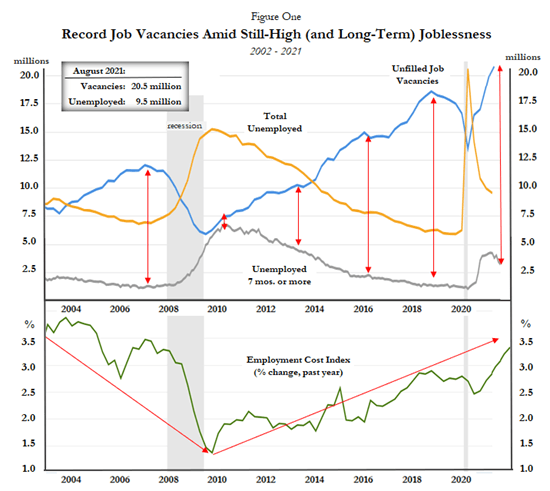The Costly but Deliberate U.S. Labor Shortage

For more than a year, due mainly to illiberal policies associated with Covid-phobia and lockdowns, the U.S. has experienced various types and magnitudes of labor shortages. In short, the quantity of labor demanded by would-be employers has exceeded quantities supplied by would-be employees, especially in the service sector. The phenomenon is neither accidental nor temporary. Joblessness has been both mandated (by shutdowns of “nonessential” businesses) and subsidized (with lucrative and extended “jobless benefits”), which makes it difficult for many businesses to attract and hire labor of sufficient quantity, quality, reliability, and affordability.
People usually complain about shortages, especially if they are persistent and prove harmful to them as buyers of necessities like food, gas, or housing. Yet few people today, except for labor-begging business owners, complain about the labor shortages. Indeed, many people, being labor suppliers who disdain the greed of profit-oriented labor hirers, like the shortage. They prefer that their labor not be a necessity, so they aren’t beholden to “the man” (aka, capitalist “exploiter”). They prefer more leisure (as we all do), especially when politicians pay them to engage in it. The point of state-based unemployment insurance benefits is that they ensure unemployment.
Hundreds of thousands of American businesses that have survived the year-and-a-half of Covid-based policy assaults are having a difficult time finding and keeping good, reliable, and affordable labor. Much of the labor pool—especially in services—has become a stagnant swamp. Millions of people prefer to stay home and take a government subsidy.
Figure One illustrates the extent of the current labor shortage in the U.S. Notice how job openings (vacancies) far exceed the number of unemployed workers – and the gap has widened over the past year or so. Worse, the long-term unemployed have become a larger share of the total unemployed. Vacancies are at record levels (20.5 million) even amid high joblessness (9.5 million). The gap between vacancies and the number of people living idly in long-term joblessness (seven months or longer) is also the widest on record. Figure One also shows employment costs rising, which ultimately trenches on profitability.
The unemployed depicted in Figure One are not those who’ve dropped out of the labor force but those who claim, while applying for and renewing their jobless benefits, that they’re looking for work but somehow can’t find it. How can they not find it, when job vacancies are at record highs? In truth, they can’t find a job that pays more than they believe they’re worth to some employer and they won’t bother taking even a slightly-lesser-paying job, because they’re now paid above-normal jobless benefits from Covid bailout spending and federal largess. This supplements what the 50 states pay in jobless benefits. Yes, some states are now decreasing or terminating jobless benefits, but the data still show a large labor shortage.

Basic economics teaches that when markets are left free, they “clear,” which means prices help equilibrate supply and demand. Neither surpluses nor shortages become material or chronic, for surpluses entail quantities supplied exceeding quantities demanded while shortages entail the reverse. Sellers facing surpluses and preferring sales and profits to excessive inventories will gladly reduce their stocks by lowering prices. Likewise, buyers who face shortages and prefer to obtain more product than not willingly pay higher prices.
Material or chronic surpluses and shortages reflect not “market failure” but the failure of governments to let markets clear. It is believed that “fairness” requires that certain prices be higher or lower than the equilibrium level. Politicians proceed to tax, regulate, price-set, and subsidize. In democracies, where majorities dominate, electorally astute, vote greedy politicians necessarily favor the larger population of employees versus employers (except to the extent they peddle their influence, via rent-selling, to extort campaign contributions from the latter). Instead of being seen for what they are – labor market manipulators – populist politicians can pose as benefactors aiding that quintessential economic contradiction, the non-working worker.
As Paul Krugman put it recently, “Workers Don’t Want Their Old Jobs on the Old Terms,” so they welcome politicized, non-economic policies that use taxpayer funds to pay the voluntarily jobless to hold out for higher wage rates than they’d otherwise deserve or obtain from the perspective of marginal productivity. For Krugman and his acolytes, this is better even than a minimum wage mandate (which Krugman also supports), as it doesn’t require employers to pay the above-market wage rate (i.e., they’re not – yet – compelled to hire overpriced labor; they can use more capital instead, as occurs at banks, gas stations, toll booths, airline check-in counters, fast-food restaurants, with automated tellers, toll takers, and kiosks).
Daniel Alpert, senior fellow in macroeconomics and finance at Cornell Law School, concurs with Krugman and declares that “Americans Don’t Want to Return to Low Wage Jobs.” Alpert blithely assumes that wage rates (all wage rates?) are “too low” and will be until and unless government intervenes forcibly to rectify the “market failure.” He fails even to relate low-wage jobs to less-skilled jobs, or to acknowledge that the problem is best rectified by introducing still more and higher-quality capital (“labor-saving devices”), not by boosting “jobless benefits” or by imposing a still-higher minimum wage rate which rational, profit-maximizing employers shouldn’t bother to pay.
Labor market “experts” have recently confirmed and fueled such anti-employer biases. A recent New York Times Op-ed by MIT economics professor David Autor was titled: “Good News: There’s a Labor Shortage.” That was the online title; the print edition was titled “The Labor Shortage Has Empowered Workers.” This assumes workers lack bargaining power under normal conditions, as when markets “clear,” supply equals demand. How can professional economists believe such nonsense? Why applaud market disequilibrium? Autor, a co-director of “the MIT Task Force on the Work of the Future,” has spent years reprising the undue fears of early 18th-century British economist David Ricardo (1772-1823) – a devotee of the socialist “labor theory of value” (LTV) – about machines displacing physicalist labor. Fear of all fears! Barack Obama, in his last major address as president in January 2017, echoed Autor’s (and Ricardo’s) themes, claiming that automation was deleterious and divisive because skilled workers who can operate technology are better paid. But of course they’re better paid; they have a skill not everyone has. Echoing the fears of many, President Obama suggested that this may justify slowing and impeding capital formation and deployment. But that favors the cronies no one dares mention: unskilled laborers perpetually on the public dole. Autor, Obama, and countless others are more concerned with achieving equity than prosperity.
By now it should be obvious, especially to experts and Presidents, that more and better capital increases labor productivity, real wages, and living standards; it also should be clear by now that capital isn’t the alien, alienating, or impoverishing force, but a frozen form of human labor – the embodied labor of brainiacs, inventors, engineers, and entrepreneurs. Capital isn’t “dead labor,” but vital, perpetual-motion labor, powered by energy and kept vibrant by maintenance and upgrades. Capital, and profit, its income, isn’t “blood-sucking” parasitism, but the lifeblood of a dynamic and flourishing capitalist economy.
Why is so much of this unclear even to people who should know better? It’s not because they don’t know basic economics, the meaning of equilibrium, or the problem of shortages. They are clearly, unambiguously, and ideologically anti-capitalist; only derivatively are they anti-employer, because they can’t deny that most employers are capitalists at least financially (if not always ideologically). Channeling Marx, those suspicious of employers today believe capitalists profit by underpaying workers what they’re “really worth” and by charging customers more than what’s proper per that unicorn model in academic economics known as “pure and perfect competition.”
The many economists who emulate Marx today remain convinced that wage rates in a capitalist system are determined not by someone’s net contribution to the total market value of goods and services created by commercially-viable enterprise – i.e., by their “marginal productivity – but arbitrarily, by employers who pay whatever they wish (including bare-bones “subsistence wages”) – and by policies that sustain a vast “reserve army of the unemployed” that’s easily exploited, because starving workers are eager to accept any job on any terms. The “army” metaphor reflects the Marxist premise that workers are conscripted and regimented in a hierarchy under the thumb of capitalists.
Short of revolution – an overthrow of capitalism itself – “democratic socialists” seek first not to prevent widespread joblessness, but to ensure that joblessness exists (especially among the less skilled) where it didn’t previously exist at all, namely, in a freer, non-emergency setting (see 2019). Next, they seek to make taxpayers – which, in their “progressive” tax code of graduated rates, means mostly the rich and corporations – will pay the jobless not to work. They believe capitalists will be induced or compelled to “do the right thing” and finally raise wage rates. A “reserve army of the unemployed” still exists in this model, but is kept “off the market” by the equivalent of a public bribe. Thus, the jobless are “liberated” from “greedy capitalists” but come to depend on politicians.
Socialists, who believe that laborers are exploited by capitalists, fight to make economies unfree. Their goal is to “turn the tables” and “expropriate the expropriators,” to ensure that capitalists (employers) are exploited by laborers (employees). Socialists accuse capitalists of paying labor next to nothing for doing something great, but their “solution” is to force taxpayers to pay greatly for labor that does next to nothing.
These themes illuminate the aims of the Biden administration and its allied Democratic socialists in the U.S. Congress; they seek to spend an additional $3-5 trillion over the coming decade—on top of their already reckless and wasteful spending over the past 18 months—on “human infrastructure.” This entails spending on labor that doesn’t work (jobless benefits, family leave, etc.), on public schooling that doesn’t work (except to corrupt and erode human capital), and on energy that doesn’t work (more costly, less reliable “renewables”). The goal is to have as many American citizens and non-citizens alike dependent on government handouts for as long as possible, dependent on politicians directly and taxpayers indirectly. It’s a deliberate policy of subsidized parasitism. Covid “lockdowns” are the ideal policy for promoting this non-labor, anti-employer agenda. Lockdowns weren’t necessary to curb the spread of Covid; they caused more harm than good. Yet millions of people today are still compelled or induced by Covid policy to stay home, shutter businesses, and take jobless subsidies.
Today’s U.S. labor shortage is both uneconomic and unnecessary, yet nonetheless what appears to be a deliberate policy aim. Sadly, the same can be said about a wide range of other anti-capitalist policies being advanced by the Biden administration.










